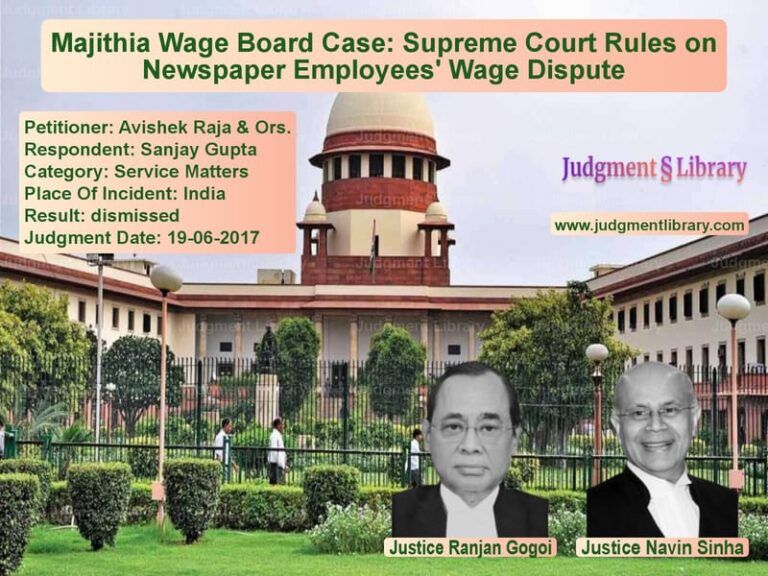Dying Declarations in Murder Cases: Supreme Court Upholds Conviction in Maharashtra Case
The case of Mehboob & Anr. vs. State of Maharashtra is a significant judgment concerning the validity of dying declarations in murder trials. The Supreme Court of India, in its ruling on October 11, 2018, upheld the conviction of the accused under Section 302 of the Indian Penal Code (IPC) for the murder of the first appellant’s wife. The conviction was primarily based on two separate dying declarations made by the deceased.
The judgment clarifies the legal position on how courts should assess multiple dying declarations and the importance of consistency in the statements of a deceased victim. The Supreme Court rejected the defense’s argument that the appellants only attempted to extinguish the fire and ruled that their actions constituted murder.
Background of the Case
The case revolves around the brutal murder of the deceased, the wife of the first appellant. The prosecution alleged that:
- The first appellant poured kerosene on the deceased.
- The second appellant (his concubine) set the deceased on fire.
- The deceased was abandoned at her paternal home after the incident.
The incident led to the registration of an FIR under Section 302 IPC (murder). During the investigation, two separate dying declarations were recorded from the deceased, which became crucial evidence in the case.
Arguments by the Appellants
The defense, represented by Mr. Chanchal Kumar Ganguly, made the following submissions:
- The first dying declaration indicated that the second appellant (the concubine) had poured water to extinguish the fire.
- The second dying declaration recorded by the Naib Tehsildar stated that both the accused had attempted to extinguish the fire.
- These statements contradicted the prosecution’s claim that the appellants intended to kill the deceased.
- Given these contradictions, the appellants should be convicted under Section 304 Part II IPC (culpable homicide not amounting to murder) instead of Section 302 IPC.
Arguments by the Respondent (State of Maharashtra)
The prosecution, represented by Mr. Nishant R. Katneshwarkar, countered the defense’s claims:
- The attempt to extinguish the fire was merely a spontaneous human instinct and did not negate their intention to kill.
- The accused did not take the victim to a hospital after the incident, which indicated their culpability.
- The deceased’s two dying declarations were consistent regarding who set her on fire, proving the accused’s guilt.
- The trial court and the High Court had correctly convicted the appellants based on these statements.
Supreme Court’s Analysis and Judgment
The Supreme Court closely examined the two dying declarations and their evidentiary value in proving the accused’s guilt.
Key Observations of the Court
- On the reliability of dying declarations: The Court reaffirmed that if a dying declaration is consistent, voluntary, and corroborated by other evidence, it can form the sole basis for conviction.
- On the attempt to extinguish the fire: The Court held that if the accused genuinely intended to save the victim, they would have taken her to a hospital instead of leaving her to die.
- On the contradiction in statements: The Court ruled that while there was mention of an attempt to extinguish the fire, this did not exonerate the accused as they had initially set her ablaze.
Final Ruling
- The Supreme Court upheld the conviction under Section 302 IPC.
- The Court ruled that no leniency could be granted under Section 304 Part II IPC.
- The Court directed that if the appellants had completed 14 years in jail (including remission), they could be considered for premature release, subject to their jail conduct.
Impact of the Judgment
The ruling has significant implications for criminal trials:
- It reinforces the principle that multiple dying declarations can be relied upon if they are consistent and voluntary.
- It sets a precedent for evaluating the intent of the accused even when they attempt to extinguish the fire after setting it.
- It highlights that courts should scrutinize the conduct of the accused post-crime to determine their true intent.
Conclusion
The Supreme Court’s decision in Mehboob & Anr. vs. State of Maharashtra is a landmark ruling affirming the evidentiary value of dying declarations in murder cases. The judgment ensures that perpetrators of heinous crimes cannot escape conviction by merely attempting to cover up their intent post-crime. This case serves as a precedent for future cases involving dying declarations and intent assessment in criminal law.
Petitioner Name: Mehboob & Anr..Respondent Name: State of Maharashtra.Judgment By: Justice Kurian Joseph, Justice S. Abdul Nazeer.Place Of Incident: Maharashtra.Judgment Date: 11-10-2018.
Don’t miss out on the full details! Download the complete judgment in PDF format below and gain valuable insights instantly!
Download Judgment: Mehboob & Anr. vs State of Maharashtra Supreme Court of India Judgment Dated 11-10-2018.pdf
Direct Downlaod Judgment: Direct downlaod this Judgment
See all petitions in Murder Cases
See all petitions in Judgment by Kurian Joseph
See all petitions in Judgment by S. Abdul Nazeer
See all petitions in dismissed
See all petitions in Declared Infructuous
See all petitions in supreme court of India judgments October 2018
See all petitions in 2018 judgments
See all posts in Criminal Cases Category
See all allowed petitions in Criminal Cases Category
See all Dismissed petitions in Criminal Cases Category
See all partially allowed petitions in Criminal Cases Category







